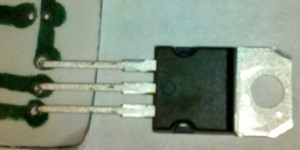PCB Etching - Home Style
The instructable that I learned this from was pretty useful, but it left out a few things that I wanted to elaborate on.
Supplies:
- A blank PCB (“copper clad”) to etch your circuit from (here’s what I got but any copper clad will work. Note: avoid the 0.127″, it’s too thick to put some leads all the way through)
- Sharpie (for etch resist)
- Muriatic acid – 20 Baume 31.45% (the 14.5% junk doesn’t work). Also take care not to murder yourself with this stuff.
- Hydrogen peroxide – 3%
- A glass container with a lid. Make sure that the lid is not airtight. If it is airtight, it can explode… acid everywhere… bad news.
- Nerd goggles (safety first)
- Particle respirator mask
- Automotive rubbing compound (from the auto parts store)
Create the etching solution
The mixture is 2 parts peroxide to 1 part acid
- Clean the glass container very well.
- Put your goggles and mask on. Do not breathe in the acid fumes.
- Pour the peroxide in first (“do what you oughta… add acid to water”)
- Pour the acid in slowly
- Now you have the etching solution. The solution should be clear at this point.
Make your circuit
- Design your circuit layout on a piece of paper first. Make sure that the components will fit on the layout. You will have to drill holes for the through-hole components so make sure that you have room for these holes on the traces. (see image below)

- Cut out a piece of copper clad that will fit the layout that you just designed.
- Clean the copper clad with some automotive rubbing compound on a paper towel. This will smooth out some of the scratches on the copper.
- Clean off all of the rubbing compound. You can wash the compound off with water. Be careful to only handle the circuit board by the edges after this to avoid getting the oils from your skin on the copper.
- Tape the paper that you designed your circuit on to your piece of copper. This will serve as your guide when you are drilling the holes for the through-hole components.
- And then… drill the holes for the through-hole components. When you’re done take off the tape and paper. Use a bigger drill bit by hand to take the rough edges off of the copper around the holes.
- Use the Sharpie to draw on the traces. This is where you want the copper to remain after etching. Essentially you are keeping the acid from eating the copper under the ink.
- Let the ink dry for a while.
- Put the board in the etchant solution to etch the board.
- Wait until all of the visible copper is dissolved. You can wait a little longer once the visible copper is dissolved, but don’t wait too long because the etchant might begin to eat under the traces.
- Take the board out (I usually drill an extra hole to put a string through so that I can pull the board out without sticking my hand or something in there).
- Wash off the board thoroughly being careful not to touch it until all of the acid has been completely rinsed off.
- Dry off the board. Paper towels work.
- Use acetone or lacquer thinner to clean off the etch resist. Make sure all of the etch resist is gone so that you won’t have a hard time soldering.
- Solder the parts in and you’re finished!
references:
http://www.instructables.com/id/Stop-using-Ferric-Chloride-etchant!–A-better-etc/